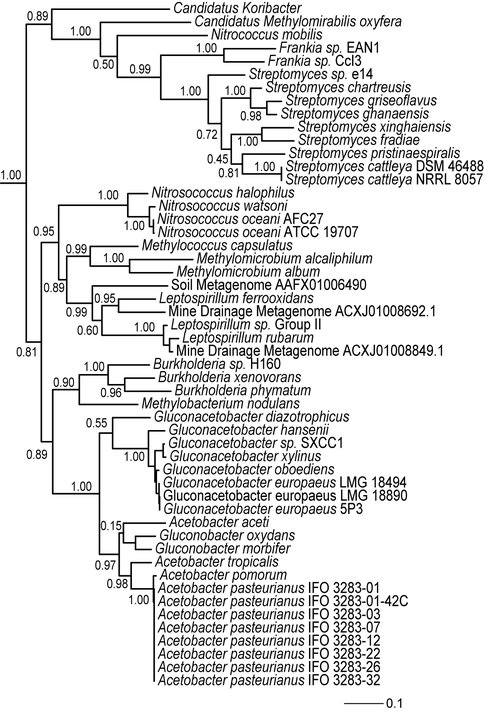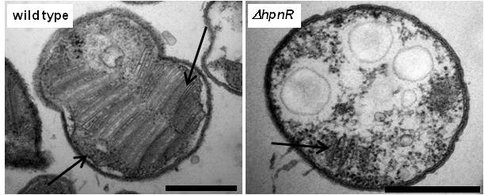2012 Annual Science Report
 Massachusetts Institute of Technology
Reporting | SEP 2011 – AUG 2012
Massachusetts Institute of Technology
Reporting | SEP 2011 – AUG 2012
Bacterial Steroids and Triterpenoids
Project Summary
Methylococcus capsulatus is one of a handful of bacteria that are capable of producing both sterols and the sterol-like hopanoid lipids. In this project, we are studying the biosynthesis and function of both sterols and hopanoids of M. capsulatus in order to gain insight into the evolutionary and functional significance of these molecules in the bacterial domain.
Project Progress
The Ediacaran period was a time of critical changes to the biosphere that may have been intimately linked to concurrent changes in global biogeochemistry. While fossil deposits of this age are rare, a rich stratigraphic record of environmental change is preserved. One such record is the Huqf Supergroup of Oman. Dated between 635Ma and the Cambrian boundary, these rocks provided a detailed record of marine chemistry through this time including major isotopic excursions in both carbon and sulfur. The Shuram carbon isotopic excursion – one of the largest deviations in Earth history- was first discovered in Oman before being found in deposits across the planet. While the causes of this isotopic excursion are as yet unknown, one hypothesis implicates major changes in Ediacaran carbon cycling that occurred simultaneously with the advent of complex life. The Shuram Excursion begins in the uppermost Khufai Formation, reaches a nadir of -12‰ in the Shuram Formation and recovers in the overlaying Buah Formation. The goal of this research is to better characterize the Khufai formation and the Shuram Excursion.
The extreme negative Shuram Excursion has also been suggested to represent a global diagenetic event. In the past year, graduate student Kristin Bergmann has conducted a more focused analysis of the diagenesis of the Shuram excursion interval using a variety of techniques to better constrain temperature and fluid history, isotopic heterogeneity, and enriched trace metal signatures. Specifically she has analyzed stratigraphically constrained samples using carbonate clumped isotope thermometry to reconstruct the temperature and fluid history of these rocks. She used a secondary ion mass spectrometer (SIMS) to compare the carbon and oxygen isotopic composition of primary carbonate grains and surrounding pore-filling cements. To deconvolve the elevated trace metal signatures of these rocks, bulk whole rock and carbonate only dissolutions were completed in conjunction with elemental mapping on the thin section scale using the electron microprobe. Results to date suggest the rocks were last equilibrated at warm temperatures (Tavg = 50) with fluids of near seawater values (δ18Ofluid ~0 permil VSMOW). Additional results suggest a mineralogical change is an important component of the excursion and much of the elevated iron signature is a result of accessory minerals like hematite and biotite while elevated manganese concentrations are found in various carbonate phases.
Our approach to understanding the Khufai-Shuram transition and the inception of the Shuram Excursion is multidisciplinary, drawing from the disciplines of stratigraphy, isotope geochemistry, and organic geochemistry. We have first created detailed lithologic logs and completed a sequence stratigraphic model to describe the depositional history. This creates a framework in which geochemical observations can be placed. We are currently employing a number of chemostratigraphic tools including carbon and sulfur isotopes and abundances to try to understand the dynamics of these geochemical cycles during this time period. Organic analysis of biomarker compounds allows for more direct questions about the biosphere by probing they type of microbial communities and the environmental conditions at the time of deposition.
Maximum likelihood phylogenetic tree of putative HpnR sequences.
A total of 192 radical AdoMet proteins were used to generate the tree: Fiftytwo
HpnR sequences plus 140 radical AdoMets with an e-value less than e−17
when queried against the M. capsulatus HpnR sequence. The tree was rooted
by using the 140 sequences as an out group to the 52 HpnR sequences shown.
Deletion of 3-methylhopanoid production results in reduced intracytoplasmic membranes during stationary phase. TEM images show ICM formation (black arrows) by cells on day 14 of growth. The ΔhpnR mutant has significantly lower ICM formation than the wild type.
Publications
-
Welander, P. V., & Summons, R. E. (2012). Discovery, taxonomic distribution, and phenotypic characterization of a gene required for 3-methylhopanoid production. Proceedings of the National Academy of Sciences, 109(32), 12905–12910. doi:10.1073/pnas.1208255109
-
Welander, P. V., Doughty, D. M., Wu, C-H., Mehay, S., Summons, R. E., & Newman, D. K. (2012). Identification and characterization of Rhodopseudomonas palustris TIE-1 hopanoid biosynthesis mutants. Geobiology, 10(2), 163–177. doi:10.1111/j.1472-4669.2011.00314.x
-
PROJECT INVESTIGATORS:
-
PROJECT MEMBERS:
Roger Summons
Co-Investigator
-
RELATED OBJECTIVES:
Objective 5.1
Environment-dependent, molecular evolution in microorganisms
Objective 5.3
Biochemical adaptation to extreme environments


